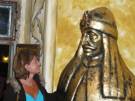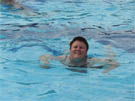Romaniaturen 2008
Nysgjerrighet, lidenskap for å reise, og et ønske om å skjønne hvordan en kommunistisk fortid har preget et land og et folk, og sist men ikke minst, et sterkt ønske om å lære noe mens man er på reise, det er noen av årsakene til at 28 forventningsfulle deltaker ble med Aktive Fredsreiser sin første tur til Romania i august i år.
Aktive Fredsreiser gikk igjen sine egne veier og arrangerte sin første temareise til Budapest og Romania i august i år. 28 deltakere la ut på en reise krydret med kunnskap. De deltok på fredsseminar på PATRIR (Romanian Peace Insitute), fikk god kjennskap til Romanias kommunistiske historie, opplevde unike naturlandskap og fikk grundig innblikk i Romanias kultur, både når det gjaldt tradisjoner, mat, økonomi og skjulte skatter. Landets ”må se” destinasjoner var selvfølgelig inkludert i reisen, som Draculas slott, Sapanta Merry Cemetary og middelalderbyer i Sighisoara…
Her forteller Andra Tanase fra Romania fra turen.
Av Andra Tanase
 Curiosity, passion for travel, seeking an understanding of what the effects of a communist past has done to a country and its people, and a deep desire to learn by traveling are some of the main reasons that drew the 28 travelers for peace to choose the Romania trip. Not that much information is available about Romania, except for of course the travel guides that many of the participants carefully studied before the trip. But the aim of this trip was to go further, to explore by experience and to study a place by listening to its people and by going beyond stereotypes.
Curiosity, passion for travel, seeking an understanding of what the effects of a communist past has done to a country and its people, and a deep desire to learn by traveling are some of the main reasons that drew the 28 travelers for peace to choose the Romania trip. Not that much information is available about Romania, except for of course the travel guides that many of the participants carefully studied before the trip. But the aim of this trip was to go further, to explore by experience and to study a place by listening to its people and by going beyond stereotypes.
 The trip started in Budapest, after a few moments of relaxing at the hotel, we toured the town and visited the House of Terror, one of the main museums testifying for the communist and fascist past of Hungary. A strong beginning giving much to think about and explaining much of the situation and mentality nowadays. Next day we followed our journey into Romania.
The trip started in Budapest, after a few moments of relaxing at the hotel, we toured the town and visited the House of Terror, one of the main museums testifying for the communist and fascist past of Hungary. A strong beginning giving much to think about and explaining much of the situation and mentality nowadays. Next day we followed our journey into Romania.
 If in the beginning people knew about Nadia Comaneci the famous gymnast, about Dracula’s legend, about the many orphans left behind by the communist regime and about Ceausescu’s dictatorial regime, by the end of the trip the information was much deeper, including a recognized surprise with the level of development in many places, a real ‘taste of Romania’ with its mici, sarmale, tripe soup and palinca, a wonderful insight into some very old salt mine that certifies one of the many natural resources thatRomania has, a real visit to the birthplace of Dracula, a glimpse into the Rroma life, a gaze of the wooden churches and light-hearted attitudes towards death in Maramures and last but not least glimpses from a communist past. The Sighet memorial visited in one of the last days provided a very detailed insight into what communism was in Romania. It presented the prison system, the intelligence, the agricultural reforms, the situation of the intellectuals and the church, and other aspects that school-text book history still did not write about.
If in the beginning people knew about Nadia Comaneci the famous gymnast, about Dracula’s legend, about the many orphans left behind by the communist regime and about Ceausescu’s dictatorial regime, by the end of the trip the information was much deeper, including a recognized surprise with the level of development in many places, a real ‘taste of Romania’ with its mici, sarmale, tripe soup and palinca, a wonderful insight into some very old salt mine that certifies one of the many natural resources thatRomania has, a real visit to the birthplace of Dracula, a glimpse into the Rroma life, a gaze of the wooden churches and light-hearted attitudes towards death in Maramures and last but not least glimpses from a communist past. The Sighet memorial visited in one of the last days provided a very detailed insight into what communism was in Romania. It presented the prison system, the intelligence, the agricultural reforms, the situation of the intellectuals and the church, and other aspects that school-text book history still did not write about.
 With so much to think about, with a mix of experiences our travelers relaxed in the Felix thermal baths before taking the trip back to Norway, richer with one experience from a rich although not wealthy country.
With so much to think about, with a mix of experiences our travelers relaxed in the Felix thermal baths before taking the trip back to Norway, richer with one experience from a rich although not wealthy country.
